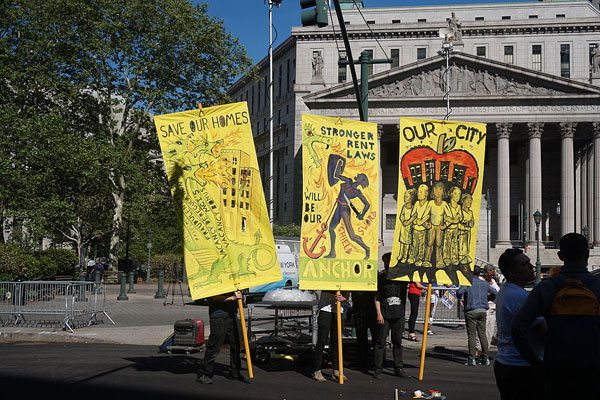
October 2, 2017; Marketplace
PRI’s Marketplace featured a report on one way that New York City is seeking to empower tenants. The article, “New York is betting $155 million that it can cut evictions,” describes the city’s effort to provide legal representation to low-income tenants facing eviction. The payoff to the city is reduced social service costs for shelter and relocation. According to Steven Banks, commissioner of the city’s Department of Social Services:
More than 59,000 people sleep in New York City’s homeless shelters every night. The new law could help people stay in their homes instead.… And there’s an economic argument for that.… To spend a couple of thousand dollars to provide legal services versus tens of thousands of dollars to provide shelter makes this a very good investment.
Support for legal representation has been championed by advocacy nonprofits in recognition of the fact that more than 90 percent of tenants go to eviction court without a lawyer.
Subsidizing legal representation in housing court is only one of a series of strategies being used to protect low-income renters. In past months, NPQ has covered other efforts, most inspired by activists in New York City, to create eviction court navigators, outlaw landlord harassment of tenants, and curtail blacklisting of tenants. Lack of affordable housing in New York City is part of a larger nest of problems faced by low-wage households. Landlords are using aggressive techniques to force tenants out of rent-controlled units so they can get higher rents from more affluent home-seekers. Predatory rental practices may have increased as demand for rental housing has risen across the country. Yet another factor shaping rental practices has been the corporatization of rental property ownership.
Sign up for our free newsletters
Subscribe to NPQ's newsletters to have our top stories delivered directly to your inbox.
By signing up, you agree to our privacy policy and terms of use, and to receive messages from NPQ and our partners.
New York’s mayor, William “Bill” de Blasio, has made expanding the number of affordable housing units a key strategy for his administration, but at the end of four years, the mayor seems unable to build his way out of the affordability problem. Eviction representation is another tactic to preserve existing affordable units.
Besides the savings to the municipal budget, there are less tangible benefits to be derived from stable rental housing. One is economic. Most cities depend on a workforce of lower wage workers who need stable rental housing to be productive employees. The nonprofit research and advocacy organization PolicyLink has a new study that details the economic impact on cities of stable rental housing and tenant-friendly public policies. A study from Cleveland State University’s College of Urban Affairs suggests that the most economically distressed city in the United States can “grow from the inside” based on the new renters.
Another benefit is political. Tenants are gaining electoral power in places like New York City. There’s an emerging social movement in US cities that’s sometimes characterized as the Renter Nation. This movement brings together young urban renters, childless boomers choosing an urban lifestyle, and former homeowners who have been displaced into single-family rentals by the Great Recession. These “new renters” are adding fuel (and political power) to the struggle of low-income households in inner-city subsidized developments. While nonprofits like Right to the City and PolicyLink are giving voice to this emerging movement, other more traditional housing advocacy and fair housing organizations are also feeling the energy. WBUR’s On Point features a segment on this profound demographic shift. Throughout the half-hour discussion, the panelists reiterate that the emergence of a renter nation is “market driven,” not an investor conspiracy.
In the early aftermath of the Great Recession, there was a sense among the FIRE (Finance, Insurance, and Real Estate) industries that homeownership would bounce back as the wreckage of foreclosed homes were sold off, as displaced owners’ credit records were cleared, and as the millennial generation reached the age for first time home buying. That hopeful scenario of 2010 now seems naïve in the face of our present reality.—Spencer Wells













